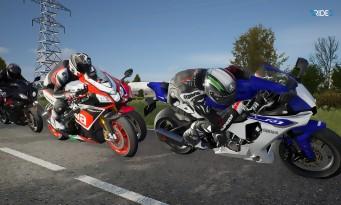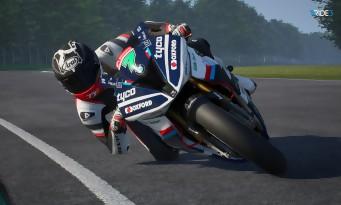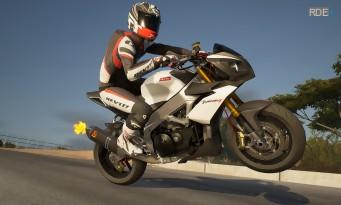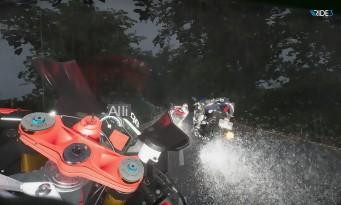 The first big piece of good news in RIDE 3 concerns the very foundations of the game, because hallelujah, Milestone has finally dropped its in-house graphics engine to use a more modern tool. In their wisdom, and following the choice of 80% of the industry, the developers have set their sights on Epic Games' Unreal Engine 4. If we don't necessarily think of him for a car game, know that Kunos Simulazioni has also chosen him for the new Assetto Corsa Competizione, which represents a real mark of confidence, especially when we know the fussy side of the innkeepers of the automotive simulator. That said, Milestone had already opted for this engine in previous MXGPs, and the result had not been up to par. Fortunately, after several games developed with the Unreal Engine 4 (MXGP 3, Gravel, MXGP PRO, MotoGP 18) the developers now seem to have the Epic Games tool well in hand. Visually, the game isn't a graphic slap, but it doesn't have to be ashamed of current productions, with superbly modeled motorcycles, fairly classy lighting effects that can create big reflections on the dashboard, and even a rather believable rain. In 2018, you no longer need to sacrifice your retinas to enjoy the most exhilarating two-wheelers on the market, and that's great news. We even take advantage of new effects in the series such as the tires that get dirty when we leave the track, or the water that squirts and forms a hell of a geyser during races on wet tracks. The gain is also visible on the different textures and surfaces, the tires having a much more realistic appearance than before, while many mechanical parts of the motorcycles are now modeled in 3D such as the footrest plates or the motorcycle shifter, even if some details remain a texture (the gearbox output sprocket for example).
The first big piece of good news in RIDE 3 concerns the very foundations of the game, because hallelujah, Milestone has finally dropped its in-house graphics engine to use a more modern tool. In their wisdom, and following the choice of 80% of the industry, the developers have set their sights on Epic Games' Unreal Engine 4. If we don't necessarily think of him for a car game, know that Kunos Simulazioni has also chosen him for the new Assetto Corsa Competizione, which represents a real mark of confidence, especially when we know the fussy side of the innkeepers of the automotive simulator. That said, Milestone had already opted for this engine in previous MXGPs, and the result had not been up to par. Fortunately, after several games developed with the Unreal Engine 4 (MXGP 3, Gravel, MXGP PRO, MotoGP 18) the developers now seem to have the Epic Games tool well in hand. Visually, the game isn't a graphic slap, but it doesn't have to be ashamed of current productions, with superbly modeled motorcycles, fairly classy lighting effects that can create big reflections on the dashboard, and even a rather believable rain. In 2018, you no longer need to sacrifice your retinas to enjoy the most exhilarating two-wheelers on the market, and that's great news. We even take advantage of new effects in the series such as the tires that get dirty when we leave the track, or the water that squirts and forms a hell of a geyser during races on wet tracks. The gain is also visible on the different textures and surfaces, the tires having a much more realistic appearance than before, while many mechanical parts of the motorcycles are now modeled in 3D such as the footrest plates or the motorcycle shifter, even if some details remain a texture (the gearbox output sprocket for example).
RACING ENGINE
 The advantage of the Unreal Engine is that it also allows for much better physics, which immediately feels racing. The suspensions work more, and you can now feel the bumps on some circuits. With this new level of realism, it will be necessary to work the trajectories in order to find the place where the asphalt is smooth as billiards, while abandoning the damaged places where the grip will be less good. We especially feel a huge difference in the rain. Where the gameplay didn't change one iota in Ride 2, riding on wet tracks in RIDE 3 offers a real challenge, especially if you've decided to do without traction control and ABS. With bikes with plenty of torque, the slightest push of throttle will cause the rear to chase, while each brake grip will have to be softer than a caress to your wife. Fortunately, with the aids, it will always be possible to make the game very accessible for novices, while seasoned pilots will be able to have fun by removing everything, which also grants a small financial bonus at the end of the race (as in Forza). A small downside, however: know that PRO physics removes combined braking (front / rear wheel on the same key), which is a significant problem for those who play with the controller. Indeed, the front brake will remain slaved to the trigger, and therefore adjustable, while the rear wheel will have to be content with a button, which implies completely locking the wheel or not braking at all, which is quite annoying. . It's all the more infuriating that the series has dragged on this defect since the first episode, without anything being done to remedy it.
The advantage of the Unreal Engine is that it also allows for much better physics, which immediately feels racing. The suspensions work more, and you can now feel the bumps on some circuits. With this new level of realism, it will be necessary to work the trajectories in order to find the place where the asphalt is smooth as billiards, while abandoning the damaged places where the grip will be less good. We especially feel a huge difference in the rain. Where the gameplay didn't change one iota in Ride 2, riding on wet tracks in RIDE 3 offers a real challenge, especially if you've decided to do without traction control and ABS. With bikes with plenty of torque, the slightest push of throttle will cause the rear to chase, while each brake grip will have to be softer than a caress to your wife. Fortunately, with the aids, it will always be possible to make the game very accessible for novices, while seasoned pilots will be able to have fun by removing everything, which also grants a small financial bonus at the end of the race (as in Forza). A small downside, however: know that PRO physics removes combined braking (front / rear wheel on the same key), which is a significant problem for those who play with the controller. Indeed, the front brake will remain slaved to the trigger, and therefore adjustable, while the rear wheel will have to be content with a button, which implies completely locking the wheel or not braking at all, which is quite annoying. . It's all the more infuriating that the series has dragged on this defect since the first episode, without anything being done to remedy it.
Collectors will be able to create a garage of madness, because the game includes more than 230 bikes including 70 novelties compared to previous games, even if we deplore some losses compared to RIDE 2, probably in order to facilitate the production of DLC packs including Milestone is so fond of it.
 Content level, RIDE 3 does not have to be ashamed with 27 circuits, and more than 40 variants including the weather conditions (fixed) and light since the night has made its arrival in the game! Collectors will be able to create a garage of madness, because the game includes more than 230 bikes including 70 novelties compared to previous games, even if we deplore some losses compared to Ride 2, probably in order to facilitate the production of DLC packs including Milestone is so fond of it. Exit the H2R or the BMW HP4, but we will console ourselves with the arrival of the formidable Suter MMX 500 which is now available immediately, and no longer sold in DLC. Customization will always be at the heart of the game, with thousands of options to customize the bike and the rider, and as always, hundreds of references from the catalogs of major props. If we will have to create our pilot with a fairly basic interface and offering few choices (we only see it in the menu anyway), his track outfit can on the other hand be made to measure with clothing from Alipinestars , Dainese, Rev'it and many others, while the helmets are supplied by all the major existing brands except the French from Shark. In terms of preparation, the options are wider than ever, since you can tackle almost all the parts of the bike, from the racing connecting rods to the polishing of the casings, via the racing exhausts. Better still, depending on the bikes, not all the options will be available, in order to fit perfectly with the mechanical reality of the model you are working on. Impossible, for example, to put titanium valves on a 2T engine (which of course has no valves), or to change the injection box of a motorcycle with carburettor. Small novelty also: know that a livery editor is now available, in order to pimp your wheel according to your desires, if ever the official decorations do not suit you.
Content level, RIDE 3 does not have to be ashamed with 27 circuits, and more than 40 variants including the weather conditions (fixed) and light since the night has made its arrival in the game! Collectors will be able to create a garage of madness, because the game includes more than 230 bikes including 70 novelties compared to previous games, even if we deplore some losses compared to Ride 2, probably in order to facilitate the production of DLC packs including Milestone is so fond of it. Exit the H2R or the BMW HP4, but we will console ourselves with the arrival of the formidable Suter MMX 500 which is now available immediately, and no longer sold in DLC. Customization will always be at the heart of the game, with thousands of options to customize the bike and the rider, and as always, hundreds of references from the catalogs of major props. If we will have to create our pilot with a fairly basic interface and offering few choices (we only see it in the menu anyway), his track outfit can on the other hand be made to measure with clothing from Alipinestars , Dainese, Rev'it and many others, while the helmets are supplied by all the major existing brands except the French from Shark. In terms of preparation, the options are wider than ever, since you can tackle almost all the parts of the bike, from the racing connecting rods to the polishing of the casings, via the racing exhausts. Better still, depending on the bikes, not all the options will be available, in order to fit perfectly with the mechanical reality of the model you are working on. Impossible, for example, to put titanium valves on a 2T engine (which of course has no valves), or to change the injection box of a motorcycle with carburettor. Small novelty also: know that a livery editor is now available, in order to pimp your wheel according to your desires, if ever the official decorations do not suit you.
OLD BIKER THAN EVER
 The campaign system has changed little, with many events reserved for each type of mount available, from sports cars to roadsters and supermotos (whose physics have evolved). Each victory brings money to pay you for motorcycles and spare parts, as well as stars that allow you to unlock new events, knowing that this system is relatively generous, which allows you to progress even without racing in the categories that bore you. As a bonus, several specific events make us relive the history of certain emblematic sports models in the history of the motorcycle, and this, by placing us at the handlebars of each evolution of these machines. We will thus relive the history of the Suzuki GSXR, the Honda Fireblade, the Yamaha R1 or the Kawasaki ZX-10R. As in Gran Turismo, completing each series of races by accumulating victories will unlock certain motorcycles that you cannot otherwise have. Those who want to ride in S1000RR will have to master the Nürburgring Nordschleife perfectly. If the legendary German circuit is still present, many other tracks have made their debut including several fanciful tracks (such as Lake Garda, or The Snake), but also big names such as Okayama, Laguna Seca, Daytona or Brands Hatch. Moreover, the tracks are rather nicely modeled with a rendering very close to reality, even if we remain far from the laser-scans of Assetto Corsa. We can however rejoice in the absence of cloned spectators, even if the abundance of Ride 3 billboards is a bit detrimental to immersion. We must also mention the arrival of the night, really pleasant in terms of the decor. On the other hand, the darkness is not really a problem for visibility, thanks to the always very clear sky which allows you to find your bearings, while all the motorcycles will be able to light the road, whether they have headlights or not!
The campaign system has changed little, with many events reserved for each type of mount available, from sports cars to roadsters and supermotos (whose physics have evolved). Each victory brings money to pay you for motorcycles and spare parts, as well as stars that allow you to unlock new events, knowing that this system is relatively generous, which allows you to progress even without racing in the categories that bore you. As a bonus, several specific events make us relive the history of certain emblematic sports models in the history of the motorcycle, and this, by placing us at the handlebars of each evolution of these machines. We will thus relive the history of the Suzuki GSXR, the Honda Fireblade, the Yamaha R1 or the Kawasaki ZX-10R. As in Gran Turismo, completing each series of races by accumulating victories will unlock certain motorcycles that you cannot otherwise have. Those who want to ride in S1000RR will have to master the Nürburgring Nordschleife perfectly. If the legendary German circuit is still present, many other tracks have made their debut including several fanciful tracks (such as Lake Garda, or The Snake), but also big names such as Okayama, Laguna Seca, Daytona or Brands Hatch. Moreover, the tracks are rather nicely modeled with a rendering very close to reality, even if we remain far from the laser-scans of Assetto Corsa. We can however rejoice in the absence of cloned spectators, even if the abundance of Ride 3 billboards is a bit detrimental to immersion. We must also mention the arrival of the night, really pleasant in terms of the decor. On the other hand, the darkness is not really a problem for visibility, thanks to the always very clear sky which allows you to find your bearings, while all the motorcycles will be able to light the road, whether they have headlights or not!
IA NOBODY
 Finally, the huge black point of RIDE 3 remains the AI, with its completely crazy reactions, its improbable characters and its moldy physics. Let us show you the extent of the damage. To avoid creating rotten names, the game collects the nicknames of other players online, before pasting them on its NPCs. We inevitably end up with strange names, and quite funny when we see S1000RR FAN riding a Kawasaki ZX-10R. Unfortunately, this system only retrieves the names and not the outfits of the players, which explains why we often face a platoon of 11 pilots, 8 of whom are sporting strictly the same equipment. Too bad eh? As far as physics are concerned, the AIs are tanks, riveted to the ideal trajectory, and which never fall, even after having bounced at 260Km/h against the low wall of an Irish country road. The problem is that the AIs never calculate you, and when there is contact, it is almost always our pilot who will end up down. We do not tell you the nervousness that this can induce in the long run. Worse, depending on the difficulty chosen, the bots will have to respect a certain lap time, and this, by using strings larger than the cables of a suspension bridge. Thus, we see pilots grilling us without sweating and with the bike flat from a standing start, while our Aprilia is already in the rear wheel. Same thing on the straights where a standard CBR 1000 (with original mirrors, pot, plates and wheels) of 185hp drops our RSV4RF boosted to 245hp. In turns, it's even more pathetic, because the AI is unable to adopt a constant speed. The system spends its time alternating between gas and brakes, which causes all AI bikes to swing back and forth as soon as they are on the corner (we do not recommend trying this in real life), and this, without ever falling of course. Finally, we have to mention quite a few small collision bugs that make us smile, like our pilot's foot going through the ground when cornering. We console ourselves with the rather good PC optimization, because the game runs without any problem at more than 200FPS in 4K all options fully on our RTX 2080 Ti, which means that any PC with a GTX 970 will be entitled at 1080p smooth in ultra.
Finally, the huge black point of RIDE 3 remains the AI, with its completely crazy reactions, its improbable characters and its moldy physics. Let us show you the extent of the damage. To avoid creating rotten names, the game collects the nicknames of other players online, before pasting them on its NPCs. We inevitably end up with strange names, and quite funny when we see S1000RR FAN riding a Kawasaki ZX-10R. Unfortunately, this system only retrieves the names and not the outfits of the players, which explains why we often face a platoon of 11 pilots, 8 of whom are sporting strictly the same equipment. Too bad eh? As far as physics are concerned, the AIs are tanks, riveted to the ideal trajectory, and which never fall, even after having bounced at 260Km/h against the low wall of an Irish country road. The problem is that the AIs never calculate you, and when there is contact, it is almost always our pilot who will end up down. We do not tell you the nervousness that this can induce in the long run. Worse, depending on the difficulty chosen, the bots will have to respect a certain lap time, and this, by using strings larger than the cables of a suspension bridge. Thus, we see pilots grilling us without sweating and with the bike flat from a standing start, while our Aprilia is already in the rear wheel. Same thing on the straights where a standard CBR 1000 (with original mirrors, pot, plates and wheels) of 185hp drops our RSV4RF boosted to 245hp. In turns, it's even more pathetic, because the AI is unable to adopt a constant speed. The system spends its time alternating between gas and brakes, which causes all AI bikes to swing back and forth as soon as they are on the corner (we do not recommend trying this in real life), and this, without ever falling of course. Finally, we have to mention quite a few small collision bugs that make us smile, like our pilot's foot going through the ground when cornering. We console ourselves with the rather good PC optimization, because the game runs without any problem at more than 200FPS in 4K all options fully on our RTX 2080 Ti, which means that any PC with a GTX 970 will be entitled at 1080p smooth in ultra.


























